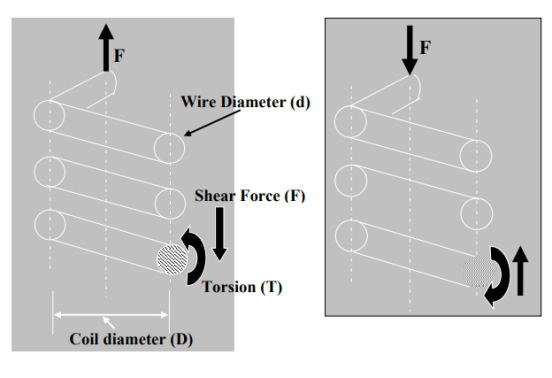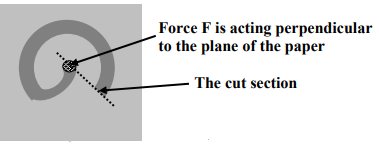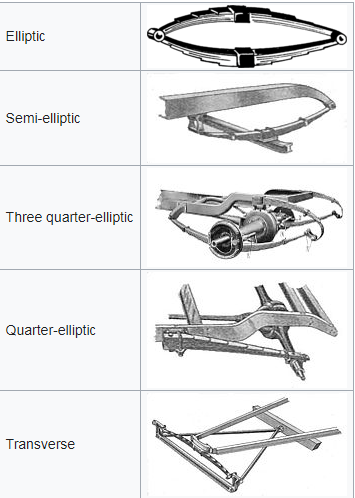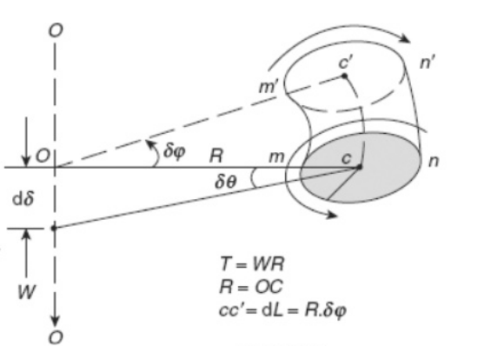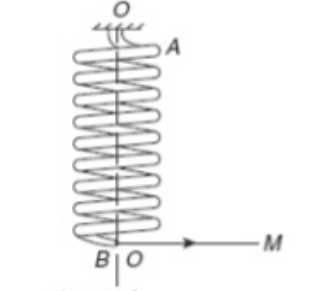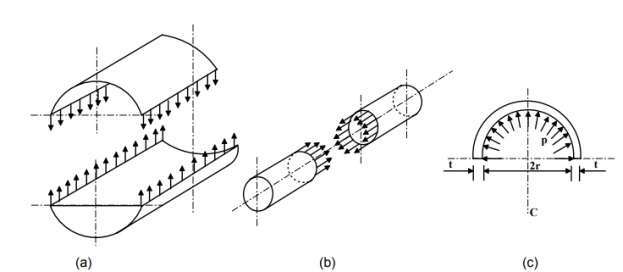Fig 1 (a) Fig 1 (b)
|
Fig.2 |
Fig.3
|
= |
Fig.4
|
 because Rd∅ = d L = length of wire considered Cc’ dδ = R δθ =
because Rd∅ = d L = length of wire considered Cc’ dδ = R δθ =  =
=  T ,Twisting moment at any section is same i. e. , WR total axial deflection , δ = 0∫2nπ
T ,Twisting moment at any section is same i. e. , WR total axial deflection , δ = 0∫2nπ  =
=  * 2nm n= No. of turns of the spring Total angle subtended to coil at the axis of spring , ∅ = 2nπ polar moment of inertia of wire , J =πd4//32.So, Axial deflection δ =
* 2nm n= No. of turns of the spring Total angle subtended to coil at the axis of spring , ∅ = 2nπ polar moment of inertia of wire , J =πd4//32.So, Axial deflection δ =  *2nπ =
*2nπ =  Q5) Explain Closed - coiled helical spring subjected to an axial momentA5)
Q5) Explain Closed - coiled helical spring subjected to an axial momentA5)
|
Fig.6 |
Helix angle X is very small. ϕ is the total angle through which one end of the spring is turned relative to the other , when couple M is applied. Work done on spring = (½) Mϕ .
Fig 6 shows a b AB of Length subjected to Bending moment M rϕ = L ϕ = L/r , Where r = Radius of Curvature. From Flexure Formula
∴ ϕ = L = 2nπR , I =
∴ ϕ =
∴ δ = |
 & δϕ' =
& δϕ' =  Total angular Twist θ, about XX-axis. θ = 0∫L δθ = 0∫L
Total angular Twist θ, about XX-axis. θ = 0∫L δθ = 0∫L  +
+ = 0∫L(
= 0∫L( +
+  ) δLAngular Twist θ = (
) δLAngular Twist θ = ( +
+  ) LL = 2πnRsecα , put in above equation.Axial deflection , δ = Rθ .δ = 2πWR2secα (
) LL = 2πnRsecα , put in above equation.Axial deflection , δ = Rθ .δ = 2πWR2secα ( +
+  )Total Angular rotation about Y Y-axis ϕ = 0∫L δθ = 0∫L (
)Total Angular rotation about Y Y-axis ϕ = 0∫L δθ = 0∫L ( +
+ ) δL Q7) Explain Open – coiled Helical Spring subjected to axial moment.A7)
) δL Q7) Explain Open – coiled Helical Spring subjected to axial moment.A7)Open coiled Helical Spring subjected to axial moment An open- coiled helical spring of mean coil radius R, Helix angle α & number of turns n is subjected to an axial moment m as shown in fig. Components of M are M' = M cos α = bending moment & T' = M sin α = Twisting moment δθ' = Angular Twist due to T' δθ' = δϕ = Angular rotation due to M' about y' y' axis = δθ = Angular Twist about xx-axis = δ ϕ ' sin α - δ ϕ ' cos α. Δθ = (
Total angular Twist . θ = ∫δθ = 0∫L M sin α cos α( L = 2 π n R sec α ∴ ϕ (Total Angular Rotation) = 2π n R sec α( |
|
1) The radial pressure ‘px’ (compressive) 2) The hoop stress fx (tensile) 3) The longitudinal tensile stress po(tensile)
Thin spherical shells
|
 Means Thin wall P.V.
Means Thin wall P.V.


